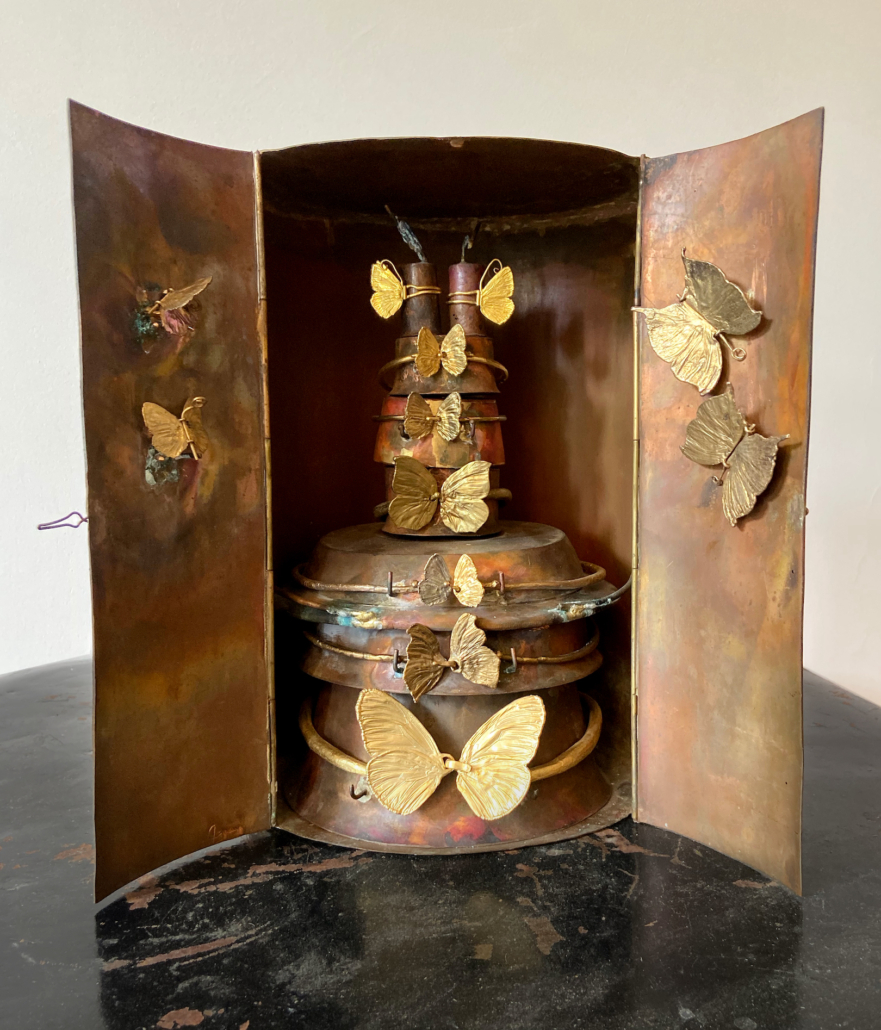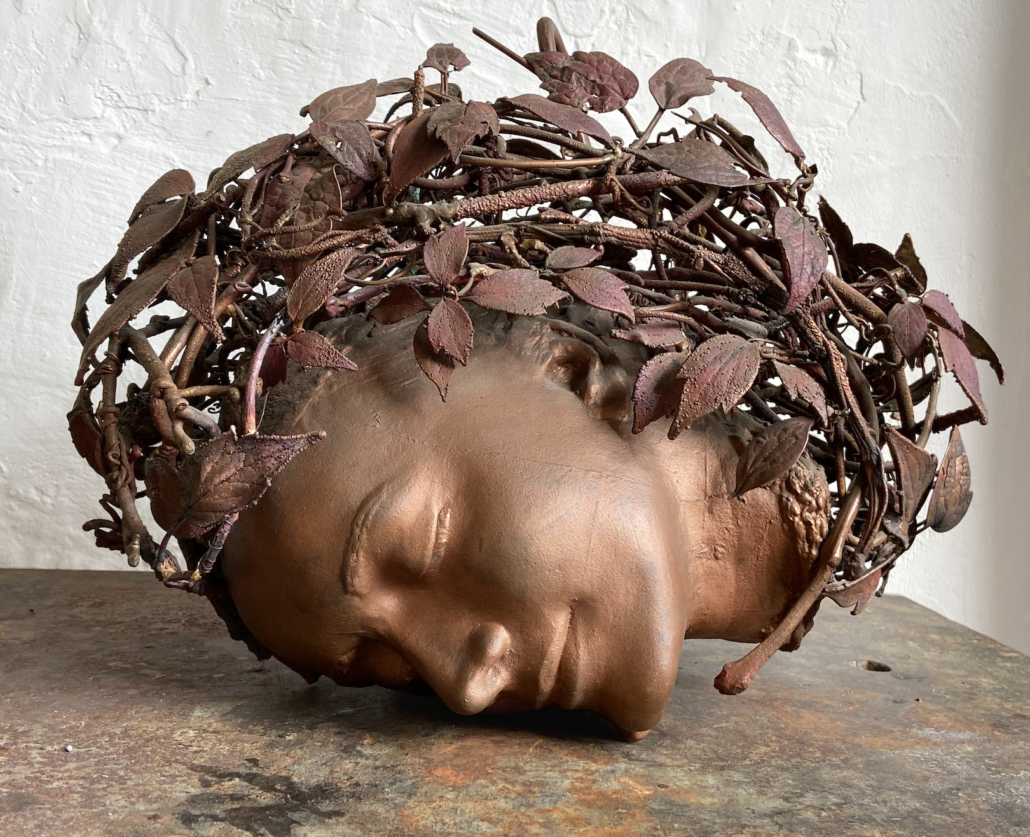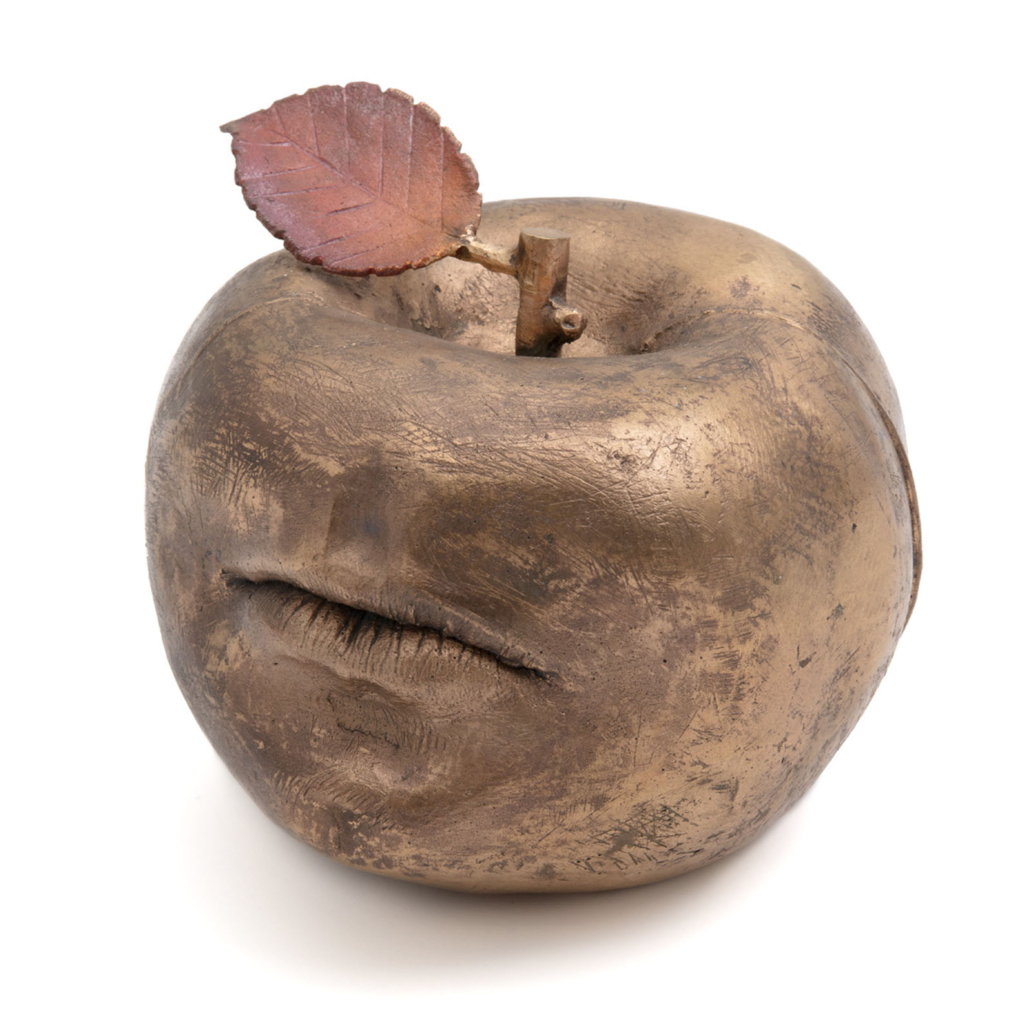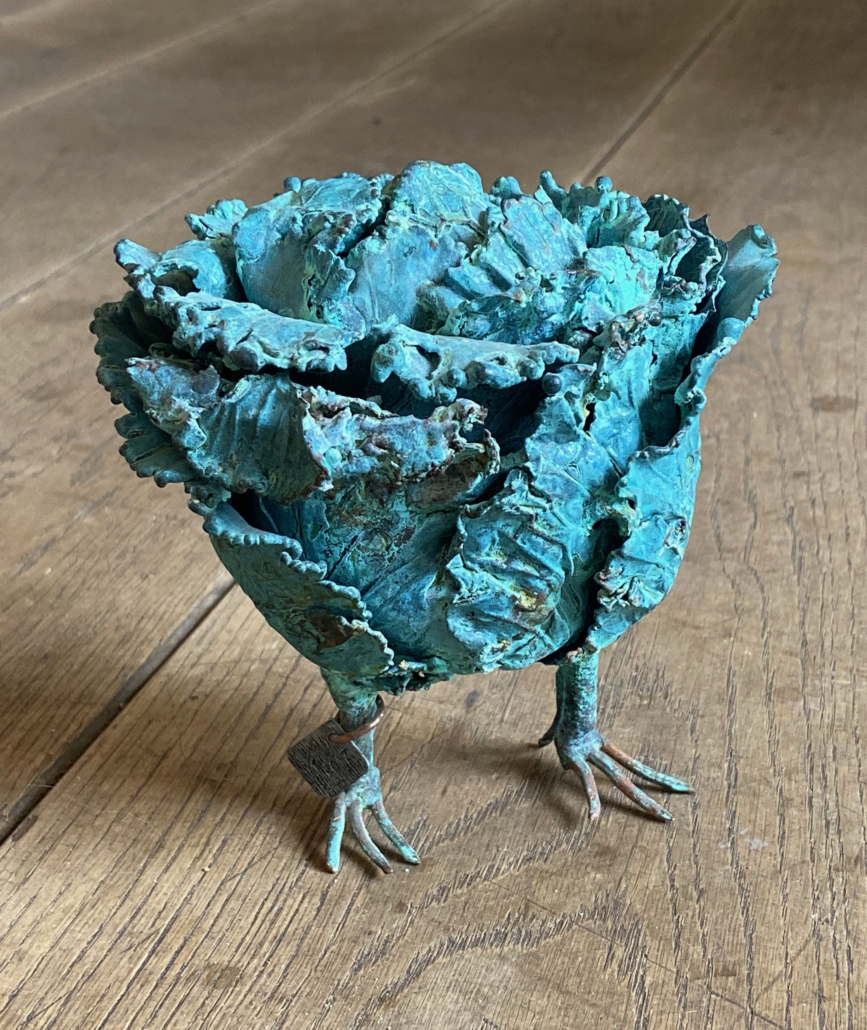
WILLIAMSTOWN, Mass. – The first art museum exhibition in the United States in more than 40 years to consider the work of sculptors Claude and Francois-Xavier Lalanne will be shown at the Clark Art Institute May 8 through October 31, 2021. Claude & Francois-Xavier Lalanne: Nature Transformed showcases twenty objects from across both artists’ long careers. The exhibition includes surreal and streamlined sculptures, dramatic and complex furniture, and a selection of Claude’s innovative flatware and jewelry. The Clark is the sole venue for the exhibition, which also marks the first museum presentation of the artists’ work since the 2019 death of Claude Lalanne.
Although Claude (French, 1924–2019) and Francois-Xavier Lalanne (French, 1927–2008) seldom collaborated on objects during their long careers, the married artists nearly always exhibited together, often under the joint name Les Lalanne. Common to both artists is the inspiration they drew from nature. From their earliest exhibition, 1964’s Zoophites—a reference to objects with a mixture of animal and plant characteristics—the artists repeatedly took flora and fauna and morphed them into something strange and new. Claude transformed familiar plants and animals into lyrical and sometimes dream-like creations, while Francois-Xavier turned his fascination with the mysterious inner life of animals into abstracted and refined sculptural forms that often concealed a practical function.

One of the earliest pieces Claude made is the unique and exquisite Le cabinet papillons (The butterfly cabinet, circa 1964). Jewelry inspired by nature would become one of Claude’s hallmarks, adorning her friends and taking its place on the runways of couturiers like Yves Saint Laurent and Christian Dior. The butterfly jewelry inside the cabinet—necklaces, bracelets, rings, and earrings (made of bronze, brass, gilded silver, and gold)—was made to be worn, then stored in plain sight.
Francois-Xavier Lalanne showed the first of his signature Moutons de Laine (Woolen sheep) flocks in 1966. Designed to be used as chairs and footstools, the initial set consisted of 24 sheep, some with heads and some without. He insisted the entire flock remain together, requiring a considerable amount of floor space that undermined any rational conception that they could have served as furniture. This sense of humor is central to Francois-Xavier’s animal-shaped creations. He later created flocks in smaller groups in both wool and cement. The set of moutons presented in Nature Transformed, assembled by the current owner from examples made between 1968 and 1971, includes three sheep with sculpted heads, including a rare black sheep, and seven headless ottomans.

Both Claude and Francois-Xavier created works that reflected their close personal relationships. Claude first exhibited a version of La Dormeuse (The sleeping woman), an intimate and highly personal sculpture that began with a life mold of the face of her daughter Caroline in 1974. A beautifully patinated 2004 version topped with a tumble of galvanized leaves is shown in the exhibition. Francois-Xavier’s Génie de Bellerive sur pylône (Genius of Bellerive on pylon, designed in 2007) is a tribute to friends and fellow artists Max Ernst and Constantin Brancusi. For her sculpture Pomme Bouche d’Alan (Alan’s apple mouth), Claude employed a wax mold of the lips of friend Alan Watson, who worked at the Musée du Louvre. The original Pomme Bouche dates to 1968, and she returned to the basic concept a number of times in her career, including the 2010 edition shown in the exhibition.

“I have long wanted to organize an exhibition about Claude and Francois-Xavier Lalanne,” said Olivier Meslay, the Clark’s Hardymon Director. “With Nature Transformed, my hopes to capture the beauty of their art, champion the fascination they inspire in others, explore their dualities and commonalities, and, above all, offer a brief and recurring moment of happiness for viewers have been realized. Although the pandemic forced us to postpone this show for a year, I think that the joyful nature of this exhibition will be even more meaningful to all of us this summer. We look forward to sharing the amazing sculptures of Les Lalanne with all of our visitors,” said Meslay.
“This exhibition reintroduces these important artists to the American museum-going public,” said exhibition curator Kathleen Morris, Sylvia and Leonard Marx Director of Collections and Exhibitions and Curator of Decorative Arts. “Nature Transformed has been in planning since 2018, and we had the privilege of meeting with Claude Lalanne just a few weeks prior to her death in April 2019, at which time she graciously gave us the approval to produce this show. American museums have neglected consideration of the Lalannes for far too long. Particularly at this moment, as the world emerges from the pandemic, it seems fitting to focus on these extraordinary sculptors and to celebrate their exuberant creativity. It’s a true honor for the Clark to have the opportunity to present their work.”

The integration of familiar objects—desk, chairs, jewelry, flatware—make the sculpture of Les Lalanne accessible and immediate. The sense of humor and joy embedded in their art has been seen by some as turning away from the need for art to interrogate the problems of the world. But these works also underscore the importance of art that celebrates life. Through the power of their artistic imagination, their impressive command of technique, and the enduring visual appeal of their life-affirming creations, Claude and Francois-Xavier Lalanne assured their place in the history of art.
Claude & Francois-Xavier Lalanne: Nature Transformed is accompanied by a catalogue authored by Morris that traces the history of Claude and Francois-Xavier Lalanne, considers the critical response to their work, and assesses their long careers within the context of the fine art museum. The catalogue is published by the Clark and distributed by Yale University Press.
ABOUT THE EXHIBITION
The first museum exhibition devoted to the Lalannes in the United States took place at the Art Institute of Chicago in 1967, followed by a 1977 display at the Art Museum of South Texas in Corpus Christi. Nature Transformed is the first American art museum exhibition dedicated to the couple since that time. As such, it brings to the foreground the art of two sculptors who longed to be accepted by the museum establishment but who forged highly successful careers without that distinction.
In 1964, Claude also showed her first two Choupattes (a term she made up, roughly translated as “cabbagefeet”) in the Zoophites exhibition at the Galerie J in Paris. To make these, she deconstructed actual cabbages, transformed the leaves into copper through the process of galvanoplasty (electrotyping), and welded the metallic leaves together, adding a pair of galvanized chicken feet. The treasured choupattes were a form that Claude returned to throughout her career. At times, as in the small Choupatte (2017) included in the exhibition, she abstracted the chicken feet and added a tiny band to one leg, mimicking the identification tags used by farmers to mark their broods.
Also at the Zoophites exhibition, her husband Francois-Xavier exhibited the first of his five large-scale metal rhinoceros sculptures. Made over his long career, each example opened to reveal interior compartments that transform the sculpture into a functional object, like a desk, as is the case of Grand Rhinocéros V (Large rhinoceros V, 1991), included in the exhibition. For this unique version, Francois-Xavier abstracted elements of the animal using geometric forms such as cubes and cylinders and worked the surface to create a rich and complex patina. The work is similar in design to Petit Rhinocéros Mécanique (Small mechanical rhinoceros,1983), which opens in multiple ways and is also presented in Nature Transformed.
Both Claude and Francois-Xavier created works that reflected their close personal relationships. Claude first exhibited a version of La Dormeuse (The sleeping woman), an intimate and highly personal sculpture that began with a life mold of the face of her daughter Caroline, in 1974. A beautifully patinated 2004 version topped with a tumble of galvanized leaves is shown in the exhibition. Francois-Xavier’s Génie de Bellerive sur pylône (Genius of Bellerive on pylon, designed in 2007) is a tribute to friends and fellow artists Max Ernst and Constantin Brancusi. For her sculpture Pomme Bouche d’Alan (Alan’s apple mouth), Claude employed a wax mold of the lips of friend Alan Watson, who worked at the Musée du Louvre. The original Pomme Bouche dates to 1968, and she returned to the basic concept a number of times in her career, including the 2010 edition shown in the exhibition.
Among the most familiar of François-Xavier’s creations are his animal bars. Meticulously planned and executed, these works demonstrate the artist’s exacting technical skills as well as his love of whimsy and surprise. La Sauterelle (The grasshopper, 1970), is a sleekly stylized sculpture of an oversized grasshopper made of porcelain and polished brass. It opens to reveal compartments for wine bottles and has wings that pivot. Only two versions were made; the other was gifted by French president Georges Pompidou to the Duke of Edinburgh in 1972 and is now in the royal collection at Windsor Castle.
Mouflon de Pauline (Pauline’s mouflon, 2007), a beautiful example of the kind of transformational animal sculpture Francois-Xavier is best known for, was originally created in 1993. The stylized mouflon, a type of wild sheep, appears to be pure sculpture, but a nearly hidden door opens to reveal a writing surface and interior desk. The sculpture reflects Francois-Xavier’s fascination with the mysterious realm of animals.
Francois-Xavier designed a group of sculptures known as Histoires naturelles (Natural histories) in 2006. The series includes large pieces fitted with candleholders; smaller sculptures; and standing vases formed of abstracted ducks, herons, sandpipers, moorhens, seaweed, water reeds, and fish. The components could be used individually or combined to create an elaborate table decoration. Nature Transformed presents a version of Histoires naturelles, Héron (Natural histories, heron) completed by the artist’s studio in 2010. In the sculpture, a heron stands among water lilies while fish swim among the water lily roots and the bird’s long legs.
Nature Transformed includes a rare collaboration between Les Lalanne. Singe aux Nénuphars (Monkey with lilies, 2008) combines a seated monkey, designed by Francois-Xavier, holding up a round tabletop formed by water lily leaves created by Claude. The version in the Clark’s exhibition is from the original edition and is cast in bronze; subsequent editions were created in gilt bronze and aluminum.
Claude’s Banc s’asseoir en forêt (Bench sitting in forest, 2017) is among the last works she completed before her death. In 2017 and 2018, Claude created two unique benches formed from tangles of cast, cut, and welded branches and vines. These works were technically complex as the natural effect Claude was seeking could only be achieved through trial and error. Elements were welded in place only to be removed and replaced or repositioned multiple times to create the look of nests of fallen branches and vines.
Click to visit the Clark Art Institute online.
# # #

